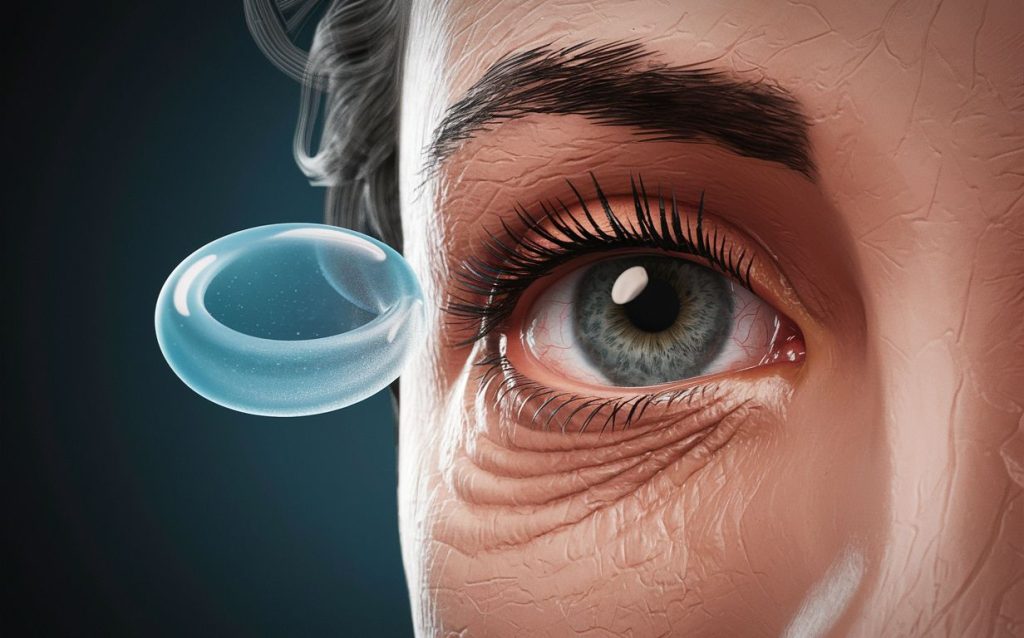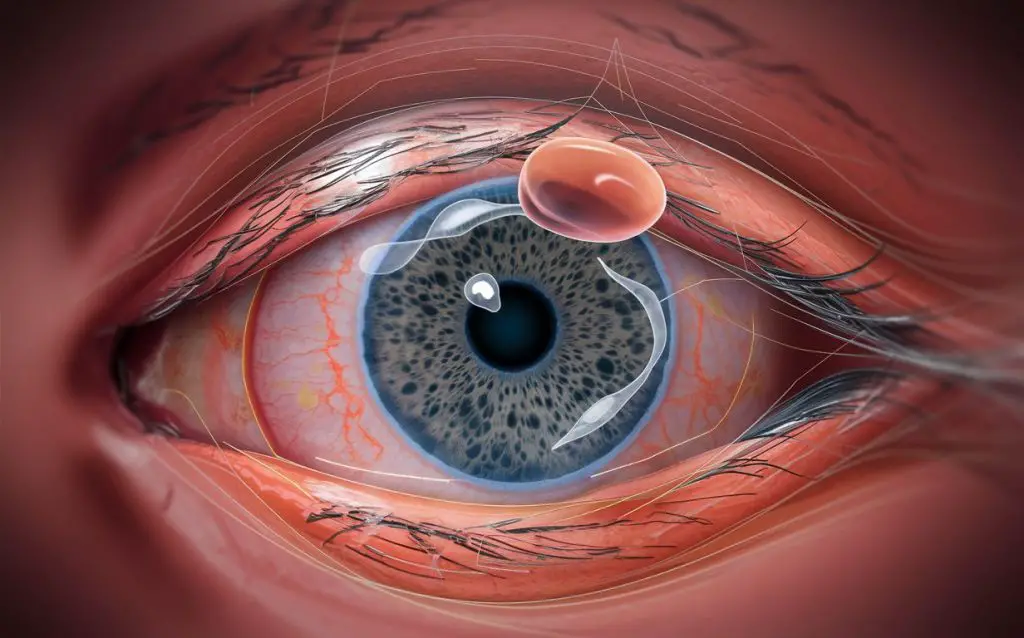Floaters are a common visual phenomenon that many people experience at some point in their lives. These tiny specks, strands, or cobweb-like shapes that drift across your field of vision can be alarming at first sight. But understanding what causes floaters and how to manage them can provide reassurance and clarity.
What are Floaters?
Floaters are small, shadowy shapes that appear to float in your field of vision. They may look like specks, dots, lines, cobwebs, or even clouds drifting across your sight. These visual disturbances often move as your eyes move and seem to dart away when you try to focus on them directly.
| Timeline | Causes | Symptoms |
|---|---|---|
| Childhood | – Congenital abnormalities | – Generally asymptomatic |
| Teenage | – Eye injuries or trauma | – Occasionally noticed as small specks or dots |
| – Inflammation (uveitis) | ||
| – High levels of myopia (nearsightedness) | ||
| – Genetic predisposition | ||
| – Diabetes mellitus | ||
| – High blood pressure | ||
| – Retinal tears or detachments | ||
| Adult | – Age-related changes in the vitreous | – Increased perception of floaters |
| – Age-related changes in the retina | – Shadows or dark spots that move with eye movement | |
| – Cataract surgery | – Blurred vision | |
| – Posterior vitreous detachment | – Flashes of light | |
| – Eye inflammation (uveitis) | – Loss of peripheral vision | |
| – Eye trauma or injury | – Sudden onset of floaters | |
| Senior | – Progression of age-related changes in the vitreous | – Severe visual disturbances |
| – Increased risk of retinal tears or detachments | – Curtain-like vision | |
| – Complications from diabetes or hypertension | – Significant reduction in visual acuity | |
| – Degenerative eye conditions (e.g., macular degeneration) | ||
| – Other age-related health conditions (e.g., vascular diseases) |
Causes of Floaters:
Floaters typically occur when the vitreous, a gel-like substance that fills the center of your eye, starts to shrink or clump together with age. As the vitreous gel changes, it can cast shadows on the retina, the light-sensitive tissue at the back of the eye, leading to the perception of floaters.
Other causes of floaters may include:
- Eye injuries or trauma
- Eye inflammation (uveitis)
- Retinal tears or detachments
- Eye surgeries, such as cataract surgery
- Certain medical conditions like diabetes or high blood pressure
Symptoms of Floaters:

Floaters are usually more noticeable when you’re looking at a plain, bright background such as a clear sky or a white wall. Some common symptoms associated with floaters include:
- Seeing specks, dots, or lines in your vision
- Shadows or dark spots that move when you move your eyes
- Difficulty focusing on objects due to the presence of floaters
- Increased perception of floaters during periods of stress or fatigue
While floaters are typically harmless, they can sometimes indicate a more serious underlying eye condition, especially if they are accompanied by flashes of light, sudden onset of floaters, or a loss of peripheral vision. In such cases, immediate medical attention is crucial to rule out any retinal complications.
Treatment Options:
In many cases, floaters do not require treatment as they tend to fade or become less bothersome over time. However, if floaters significantly impair your vision or are causing undue distress, several treatment options may be considered:
- Vitrectomy: This surgical procedure involves removing the vitreous gel along with the floaters and replacing it with a saline solution. Vitrectomy is typically reserved for severe cases of floaters that significantly interfere with vision.
- Laser Therapy: Certain types of floaters, particularly those caused by retinal tears or detachments, may be treated with laser therapy. The laser is used to break up the floaters or seal the retinal tear, reducing their visibility or preventing further complications.
- YAG Laser Vitreolysis: In this minimally invasive procedure, a laser is used to target and break up larger floaters into smaller, less noticeable fragments. YAG laser vitreolysis is often preferred for treating bothersome floaters without the need for surgery.
- Observation: For mild cases of floaters that do not significantly impact vision or quality of life, a watch-and-wait approach may be recommended. Regular monitoring by an eye care professional is important to ensure that any changes in floaters or visual symptoms are promptly addressed.
How to Reduce Floaters in Eyes Naturally
Recipe 1: Vitamin-Rich Smoothie for Eye Health
Ingredients:
- 1 cup spinach (fresh or frozen)
- 1/2 cup blueberries (fresh or frozen)
- 1/2 ripe avocado
- 1 small banana
- 1 tablespoon chia seeds
- 1 cup almond milk (or any milk of your choice)
- Ice cubes (optional)
Instructions:
- Wash the spinach and blueberries thoroughly.
- In a blender, combine the spinach, blueberries, avocado, banana, chia seeds, and almond milk.
- Blend until smooth and creamy. If desired, add ice cubes and blend again until well combined.
- Pour the smoothie into a glass and enjoy it as a nutritious snack or breakfast option.
- Consume this vitamin-rich smoothie regularly to support overall eye health and potentially reduce floaters naturally.
Recipe 2: Omega-3 Rich Salad for Eye Nourishment
Ingredients:
- 2 cups mixed greens (such as spinach, kale, and arugula)
- 1/2 cup sliced carrots
- 1/2 cup cherry tomatoes, halved
- 1/4 cup sliced cucumber
- 1/4 cup sliced bell peppers (any color)
- 1/4 cup walnuts or almonds
- 2 tablespoons extra virgin olive oil
- 1 tablespoon balsamic vinegar
- Salt and pepper to taste
Instructions:
- Wash and prepare all the vegetables and fruits as needed.
- In a large salad bowl, combine the mixed greens, carrots, cherry tomatoes, cucumber, bell peppers, and nuts.
- In a small bowl, whisk together the olive oil, balsamic vinegar, salt, and pepper to make the dressing.
- Drizzle the dressing over the salad and toss gently to coat all the ingredients evenly.
- Serve the salad immediately as a side dish or add grilled chicken or tofu for a complete meal.
- Regular consumption of this omega-3 rich salad can provide essential nutrients for eye health and may help reduce floaters naturally.
Recipe 3: Herbal Eye Soothing Tea Blend
Ingredients:
- 1 teaspoon dried chamomile flowers
- 1 teaspoon dried eyebright herb
- 1 teaspoon dried bilberry
- 1 teaspoon dried nettle leaf
- Honey or lemon (optional, for taste)
- 2 cups water
Instructions:
- In a small saucepan, bring the water to a boil.
- Remove the saucepan from heat and add the dried chamomile flowers, eyebright herb, bilberry, and nettle leaf to the hot water.
- Cover the saucepan and let the herbs steep for 5-10 minutes.
- Strain the herbal tea into a cup using a fine-mesh sieve or tea infuser.
- Add honey or lemon to taste, if desired.
- Sip on this herbal eye soothing tea throughout the day to promote eye health and alleviate discomfort associated with floaters.
- Regular consumption of this herbal tea blend may help reduce floaters and support overall eye wellness naturally.
These recipes incorporate nutrient-rich ingredients known to support eye health and may help reduce floaters naturally when consumed as part of a balanced diet and healthy lifestyle. However, it’s essential to consult with a healthcare professional for personalized advice and to rule out any underlying medical conditions contributing to floaters.
Unfortunately, there’s no scientifically proven way to completely get rid of eye floaters naturally.
Floaters are deposits that form in the vitreous gel, a jelly-like substance that fills your eyeball. While they can be bothersome, they’re usually harmless.

However, there are some lifestyle changes that might make them less noticeable:
- Diet: A balanced diet rich in antioxidants, like fruits and vegetables, might help eye health in general. Some studies suggest specific antioxidants like lutein and zeaxanthin may be beneficial, but more research is needed.
- Hydration: Staying hydrated ensures your body functions optimally, including your eyes. While there’s no direct link between water intake and floaters, dehydration can contribute to eye strain, potentially making floaters more apparent.
- Rest: Adequate sleep allows your body to repair and rejuvenate itself, potentially reducing eye stress and making floaters seem less bothersome.
- Eye strain reduction: Limit screen time and take breaks to focus on distant objects. This can help reduce overall eye strain.
If you notice a sudden increase in floaters, flashes of light, or a curtain-like shadow in your vision, consult an ophthalmologist immediately. These could be signs of a more serious eye condition.
Conclusion:
Floaters are a common and usually benign visual phenomenon that many people encounter as they age. While they may be bothersome, especially when they first appear, floaters typically do not require treatment and tend to improve over time. However, if you experience sudden onset of floaters, flashes of light, or other visual disturbances, it’s essential to seek prompt evaluation by an eye care specialist to rule out any underlying eye conditions. With proper management and monitoring, you can navigate floaters with clarity and peace of mind.





